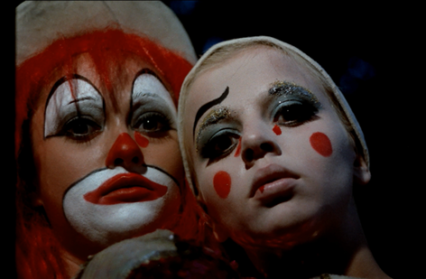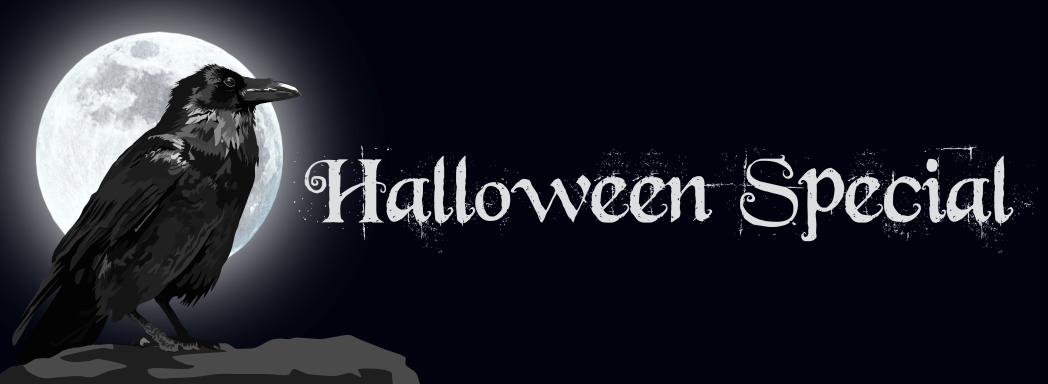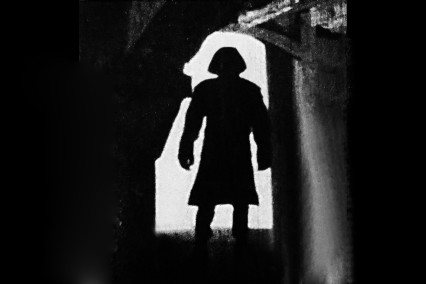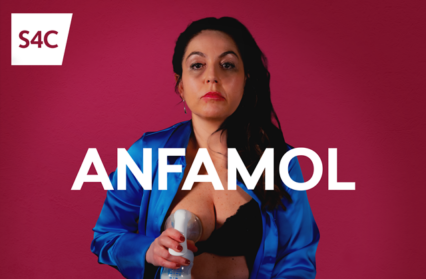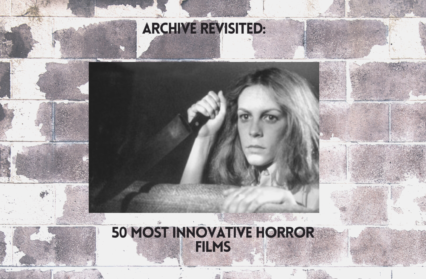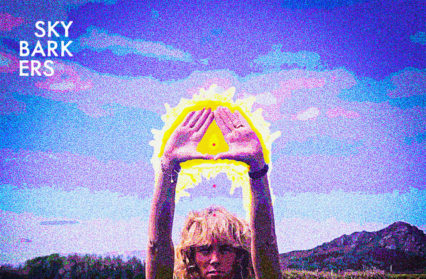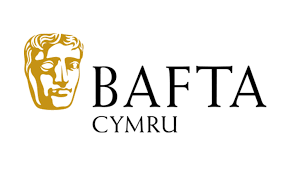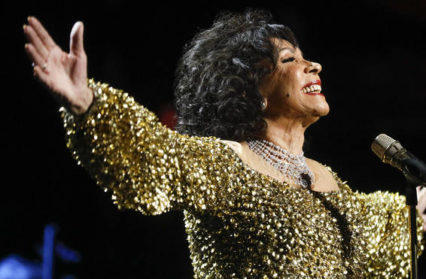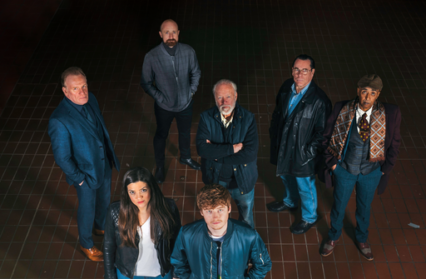Gary Raymond and Gray Taylor present a list of the greatest horror movies you may not have heard of – the perfect list for all those who are looking for something a little different on Halloween. We count down every day this week, revealing the top 10 on Halloween itself. So today, we continue with the greatest horror movies 40-31!
(Banner illustration by Dean Lewis)
50 Greatest Horror Movies 40-31:
[Warning: Some of the accompanying trailers in this article are not for the fainthearted)
40. Starry Eyes (2014. Dir: Kevin Kolsch and Dennis Widmyer)
Possibly the most bucolic treatment any film-maker has ever given Hollywood, Starry Eyes is the horror cousin of Mullholland Drive and Ivan’s XTC, the extra ten yards of crazy from Maps to the Stars. Bold ambition, bitchiness and paralyising insecurities are matched with occultism, demonology and raw, brutal horror. Again, reminiscent of Naomi Watts’ career-defining turn in David Lynch’s Mullholland Drive, Alexandra Essoe’s stunning central performance is what makes the film so affecting. And when the blood-letting finally comes, there is no holding back. Brutal stuff. GR
39. The Happiness Of The Katakuris (2001. Dir. Takashi Miike)
The incredibly prolific director Miike has forged a career usurping genre expectations; first with yakuza gangster movies, like Fudoh: The Next Generation and the Dead Or Alive trilogy, then spectacularly with horror. Miike’s films cross genres and take unsuspected plot turns into fantasy, all of which adds to the disorientating horror. The Happiness Of The Katakuris largely avoids some of the more extreme imagery of his other horrors like Gozu, but still relishes in surreal visuals and, this time, musical numbers. Beautifully shot and realised, Miike’s vision come across like The Sound Of Music with zombies, yes, as good as that sounds! GT
38. Der Golem (1915. Dir: Paul Wegener and Henrik Galeen)
This Czech silent movie is a straight telling of the Jewish folktale of the golem, a supernatural being built by a wizard out of clay and given life to defend the city from oppressors, who then, once the defending is done, continues his imperious rampage upon his own people. For silent movies like Der Golem, the term ‘dated’ is not quite right – movies like this are otherworldly now, not ‘other-timely’. Der Golem is a morality tale played out in stunning sepia and dream-like scenery. And the blank-eyed, implacable monster can be seen in uncountable creations since, from Karloff’s creature, through to Leatherface and Michael Myers. This is where it all began. GR
37. Blood On Satan’s Claw (1970. Dir. Piers Haggard)
British horror of the sixties and seventies reveled in a historical sense of terror, both physically and mentally, and the sense that our ancestors may have worshipped and colluded with darker forces than we know today. This film is perhaps the greatest example of the genre that Mark Gatiss has referred to as ‘folk horror’ and British film company Tigon didn’t hold back on that streak of seventies nastiness. Depicting an 18th century England infested by the Devil, creating murderous children in an attempt to re-enter our world, growing its skin and claws on the unsuspecting locals. Sold at the time as an exploitation movie and picked up by AIP in America, its distribution history seriously undervalues what a truly powerful example of British horror this is. GT
36. Requiem for a Vampire (1971. Dir: Jean Rollin)
Rollin was a master of style, somewhere in his vision between the slashed expressionism of Argento and the lush gothic sensibilities of Bava and the Hammer studio. As for plot, you’ve very much come to the wrong guy. What you get with Rollin is visceral horror and powerful horror imagery (how could you forget the crucifixion of the Mirella Rancelot in Grapes of Death?) matched with, in this case, a rather salacious attention to the female form. But Rollin, at least with his early vampire movies, was doing whatever he needed to get his movies financed, and the fact he did it with such undeniable artfulness, and such a keen eye for the weird, is the thing that has made his name last. GR
35. Tale Of Two Sisters (2003. Dir. Kim Jee-woon)
A psychological horror-drama from South Korea that has the ability to remain under the skin for a long time after viewing it. A film that involves you in the potential visions of the insane and teases you to unravel the mystery of what is real or what is potentially imagined by a girl named Su-mi after she has been treated at a psychiatric hospital. The presence of a wicked stepmother lends an air of fairy tale to the proceedings, but is this the stepmother through Su-mi’s eyes? Psychological horror at its best, the film is the highest grossing Korean horror film and the first to be screened in American theaters. GT
34. Dawn of the Dead (2004. Dir: Zack Snyder)
Controversial? I don’t think it is. Snyder’s remake of the great Romero satire updates in all the places it absolutely had to and hits the mark every single time. Zombies no longer amble, they come at you with a terrifying ferocity and pace. The movie has a modern sense of humour, a real attention to the nastiness that simply must be in a zombie movie, and a superb cast including Ving Rhames, a brilliant Sarah Polley (before she became one of the most interesting film-makers around), and a pre-Modern Family Ty Burrell enjoying his time as an unapologetic asshole. It doesn’t forget to be a satire on George Dubya’s America, either. A fabulous remake. GR
33. The Company Of Wolves (1984. Dir. Neil Jordan)
Jordan’s film cleverly taps into the darkness that exists in many of the fairy tales read to us as children, but also has a good stab at reinventing the portmanteau horror film made popular by Amicus Studios in the sixties and seventies. Adapted by Jordan and Angela Carter, from her original short stories, the finished script has more in common with Carter’s 1980 radio adaptation. This traditional storytelling pervades the film and leads to a feeling of unbalance when mixed with the gory special effects: this is truly an adult fairy tale, one that only works because the terror remains in our subconscious since childhood. GT
32. Brides of Dracula (1960. Dir: Terence Fisher)
A largely overlooked Hammer masterpiece, one of Terence Fisher’s high points as a director, and perhaps Peter Cushing’s finest outing as Professor Van Helsing. All that seems to be missing is Christopher Lee as Dracula – but there is no Dracula. Instead we have David Peel’s Alan Ladd-ish Baron Meinster, a very persuasive stand-in who makes a wise decision to not simply do Lee impressions. Meinster is very much his own villain. There are a series of memorable scenes, not least the brides themselves crawling through the freshly turned soil of a graveyard, hissing encouragement to their sister beneath. And it’s bloody. A bravura Hammer offering, made at the height of the studio’s creative powers. GR
31. Dr. Jekyll And Sister Hyde (1971. Dir. Roy Ward Baker)
Here it is! The greatest horror film about sexual identity and cross dressing ever made. This was Hammer’s third attempt at Robert Louis Stevenson’s classic novella and is contemporaneous to Amicus Studios own admirable adaptation, I, Monster, but this is the most delirious fun. The late, great Ralph Bates plays Dr. Henry Jekyll searching for the elixir of life by using female hormones from recently murdered women, reasoning that females live longer than males. But, guess what? That’s right, rather than turn him into a murderous animal, he is transformed into an absolutely captivating Martine Beswick. Throw in Burke and Hare, Jack the Ripper, and a good dose of classic early seventies Hammer Grand Guignol, and you have one of the most deliriously fun horrors Britain has produced. GT
Click HERE for 50-41
Click HERE for 30 to 21.
Greatest Horror Movies 40-31
Greatest Horror Movies 40-31


